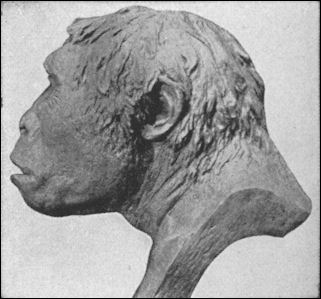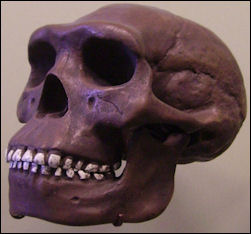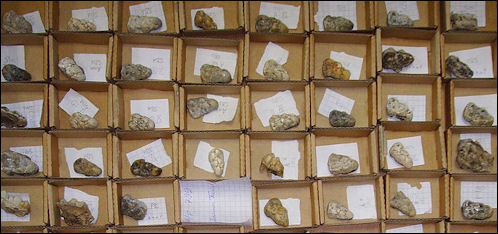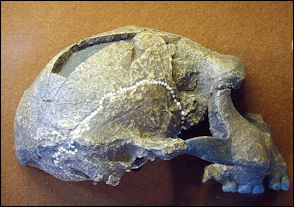HOMO ERECTUS IN INDONESIA

Java Man Indonesia is of crucial importance to the study of human origins and evolution. Sites in central Java, such as Sangiran and Ngandong, now account for about 75 percent of the world’s examples of “homo erectus”, an early hominid type. The main Homo erectus sites in Indonesia are: Sangrian 1.6 to 1 million years ago; Mojokerto, 1.5 million years ago; Trinil (Java Man), 1 million to 700,000 years ago; Ngandong, 117,000 to 108,000 years ago; [Source: Library of Congress *]
Beginning in the 1890s, paleontologists discovered fossil remains of creatures on the island of Java that, while probably not the direct ancestors of modern humans, were closely related to them. These Javan hominids, known by scientists as Homo erectus, lived 500,000 years ago and some possibly as long as 1.7 million years ago. Their remains are identified as Jetis — the earlier specimens found in eastern Java — and Trinil — later specimens found in Central Java, including the Solo River area. Evidence of probable descendants of the Trinil erectus, known as Homo soloensis or Solo Man, was found at Ngandong, also in Central Java; these descendants are thought to have evolved between 500,000 and 100,000 years ago. Assemblages of stone tools have not clearly been tied to Homo soloensis, but there is evidence that these early Homo sapiens had a rudimentary social organization (small hunting and gathering bands) and used simple tools around 40,000 years ago. *
Many observers agree that the modern inhabitants of Indonesia may be descended from Homo erectus. Although insufficient paleographical information makes it impossible to determine precisely the dates of migrations by modern Homo sapiens, contrary to earlier hypotheses of migration from the Malay Peninsula, many experts believe that Indonesia's early population — comprised of the ancestors of most of its present inhabitants — was the product of continued hominid evolution within the archipelago. There was, of course, continuing seepage of other populations into the gene pool, contributing to the complex ethnographic picture of Indonesia. That the archipelago may have developed its own Homo sapiens line has not been ruled out by some scholars. *
H. erectus is believed to be have been the first hominin to have dispersed from Africa, and they spread as far as northern China (Zhoukoudian, Peking Man) and Java. Some researchers thought that H. erectus and modern humans (homo sapiens) lived at the same time and modern humans may have descended from homo erectus. However, based on current dating of homo erectus and modern humans in Java, this theory has largely been dismissed. T is now believed that homo erectus became extinct on Java a little more than 100,000 years ago and the first modern humans arrived in Indonesia around 55,000 years ago or later.
Websites and Resources: Modern Human Origins modernhumanorigins.com ; Talk Origins Index talkorigins.org/origins ; Hall of Human Origins American Museum of Natural History amnh.org/exhibitions ; Time Space Chart Hominid Fossils Pictures msu.edu/~heslips ; Smithsonian Human Origins Program humanorigins.si.edu ; Wikipedia article on Human Evolution Wikipedia ; Becoming Human University of Arizona site becominghuman.org ; Human Evolution Images evolution-textbook.org ;Hominid Species talkorigins.org ; Institute of Human Origins iho.asu.edu ; Paleoanthropology Link talkorigins.org ; Britannica Human Evolution britannica.com/EBchecked/topic/275670/human-evolution ;Modern Human Origins modernhumanorigins.com ; Human Evolution handprint.com ; Paleoanthropology and Evolution Links unipv.it/webbio/dfpaleoa ;National Geographic Atlas of the Human Journey genographic.nationalgeographic.com/genographic/atlas ; Yale Peabody Museum peabody.yale.edu/exhibits/fossils ; Human Origins Washington State University wsu.edu/gened/learn-modules ;
Book: The Human Evolution Source Book
Java Man
Java man was discovered by Eugene DuBois, a young Dutch military doctor, who came to Java in 1887 with the sole purpose of finding the "missing link" between humans and apes after hearing about discoveries of ancient human bones (which later turned out to belong to modern man) near the Javanese village of Wajak, near Tulung Agung, in eastern Java.
With the help of 50 East Indian convict laborers, he discovered a skull cap and thighbone — that clearly didn't belong to an ape — along the banks of the Sunngai Bengawan Solo River in 1891. After measuring the cranial capacity of the skull with mustard seeds, Dubois realized that the creature was more of an "ape-like man" than a "man-like ape." Dubois dubbed the find “Pithecanthropus erectus”, or "upright ape-man,” which is now regarded as an example of “Homo erectus”.
The discovery of Java Man was the first major hominid find, and helped launch the study of early man. His finding created such a storm of controversy that Dubois felt compelled to re-bury the bones for 30 years to protect them.
DuBois was the student of Ernst Haeckel, a Charles Darwin disciple who wrote “History of Natural Creation” (1947), which advocated the Darwinian view of evolution and speculated about primitive human beings. Dubois came to Indonesia with the ambition of confirming Haekel’s theories. He died a bitter man because his discoveries he felt weren't taken seriously.
After Dubois other Homo erectus bones were unearthed in Java. In the 1930s, Ralph von Koenigswald found fossils, dated at be 1 million years old, near the village of Sangiran, along the Solo river, 15 kilometers north of Solo. Other fossils have been found along the Sungai Bengawan Solo in Central and East Java and near Pacitan in East Java’s south coast. In 1936 a skull of a child was found at Perning neat Mojokerto.
Book: “Java Man” by Carl Swisher, Garniss Curtis and Roger Lewis.
Homo Erectus

Java Man skull “Homo erectus” had a considerably larger brain than “Homo habilis”, its predecessor. It fashioned more advanced tools (double-edged, teardrop-shaped "hand axes" and "cleavers" ) and controlled fire (based on the discovery of charcoal with erectus fossils). Better foraging and hunting skills, allowed it to exploit its environment better than “Homo habilis” Nickname: Peking Man, Java Man. “Homo erectus” lived for 1.3 million years and spread from Africa to Europe and Asia. Paleontologist Alan Walker told National Geographic, “Homo erectus “ "was the velociraptor of its day. If you could look one in the eyes, you wouldn't want to. It might appear to be human, but you wouldn't connect. You'd be prey."
Geologic Age 2 million years to 100,000 years ago. Homo erectus “ lived at the same time as “Homo habilis “ and “Homo rudolfensis” and later at the same time as Neanderthals and modern humans, but not necessarily in the same places. Linkage to Modern Man: Regarded as a direct ancestor of modern man, May have had primitive language skills. Discovery Sites: Africa and Asia. Homo erectus“ fossils have been found in eastern Africa, southern Africa, Georgia, Algeria, Morocco, China and Java.
See Separate Article: HOMO ERECTUS: factsanddetails.com
Prehistoric Indonesia
Indonesia consists of parts of the Sunda Shelf, extending from mainland Asia and forming the world’s largest submerged continental shelf; a deep-water channel charting what is known as Wallace’s Line roughly running between the islands of Kalimantan and Sulawesi, and between the islands of Bali and Lombok; and parts of the Sahul Shelf, an extension of Australia. Despite arcs of frequent volcanic activity and patterns of rising and falling sea levels, this has been a favored region for modern humans and their hominid predecessors for nearly 2 million years. [Source: Library of Congress *]
About 800,000 years ago, some early hominids of the archipelago made stone tools, constructed water craft sophisticated enough to cross 25 kilometers of rough sea channel, and may have used fire and language. About 600,000 years ago, a fairly sophisticated hominid culture was widely distributed throughout what is now Indonesia. The earliest modern humans cannot currently be firmly dated before about 40,000 years ago, but some specialists argue either that they appeared much earlier (as much as 90,000 years ago) in a rapid dispersal from Africa, or that they evolved independently in East or Southeast Asia from existing hominid stock. Whatever the case, Indonesia’s earliest modern humans did not immediately or everywhere displace their hominid relatives but coexisted with them for tens of thousands of years. The earliest modes of their existence show little evidence of having deviated markedly from those of their predecessors. A pattern evolved of small hunting-fishing-foraging communities depending on tools made of shell, wood, bamboo, and stone, adapting to a wide variety of ecological niches and remaining in contact with neighboring peoples over land and sea. *
The earliest inhabitants of Indonesia are believed to have been Homo erectus (See Below). The 2004 announcement of discoveries on the island of Flores (between Bali and Timor) created international controversy because they suggested an entirely new, locally evolved, and distinctively smaller hominid form overlapping chronologically with both “homo erectus”and modern humans.
Redating Java Man
In 1994, Berkeley scientist Carl Swisher shook up the paleontology world when he redated the volcanic sediments of a “Homo erectus” Java man skull using a sophisticated mass spectrometer — that accurately measure the radioactive decay rates of potassium and argon found in volcanic sediments — and found that the skull was 1.8 million years old instead of 1 million years old as was previously reported. His discovery placed “Homo erectus” in Indonesia, some 800,000 years before it was thought to have left Africa. Critics of Swisher's findings say that the skull may have been washed into older sediments. In response his critics Swisher has dated numerous sediment samples taken where hominid fossils were found in Indonesia and found that most of the sediments were 1.6 million years old or older.
Java Man was redated again, by an Indonesian-Japanese team, in the late 2010s and found to be not as old as previously thought. The new estimate, published in the journal Science, dated Homo erectus fossils in the Sangiran dome by around 1.3 million years old, and no older than 1.5 million years old. That’s at least 300,000 years younger than Swisher’s 1.8 million year old figure from the 1990s — a date that was always controversial because other studies came come up with much younger estimates for Homo erectus at Sangiran, ranging from 1.3 to 0.6 million years old. [Source: Dyani Lewis, Cosmos, January 9, 2020]
Dyani Lewis wrote in Cosmos: To figure out whether the fossils were older or younger, Shuji Matsu’ura from the National Museum of Nature and Science in Tsukuba City, Japan, and colleagues used two separate dating techniques not previously used at the site. “It was exciting to know which chronology would be supported by the new method,” says Masayuk Hyodo from Kobe University, a senior author on the study.
Uranium-lead dating, which measures the crystallisation age, and fission track dating, which measures the volcano eruption age, of zircon grains show that volcanic ash just below the fossil-bearing layers are just 1.3 million years old. “The combination of uranium-lead and fission track is a really nice combination,” says Kira Westaway, who led a study revising the youngest erectus remains on Java. It’s dating two different events, so if you get an agreement between the two, then you really know that you’re onto something,” she says.
The younger age of first appearance at Sangiran fits with other remains on Java that have been dated to 1.49 million years old. It also puts to bed ideas that the birthplace of Homo erectus could have been in Southeast Asia. It now seems much more likely that Homo erectus arose in Africa and dispersed out through Georgia in the Caucasus, where the oldest Homo erectus remains aged 1.85 million years old have been found. From there, they dispersed into Asia. “People say, ‘well, it’s only a few hundred thousand years, who cares?’ But it really is a big deal,” says Westaway.
Sangiran: Home of Java Man
Skull from Sangiran Sangiran (16 kilometers from Solo in Central Java) is near where the skull of "Java Man" was found. A small museum is dedicated to the ancient fossil. The story of Java Man begins over a century ago. In 1890, when Eugene Dubois, a Dutch military physician and paleontologist discovered a fossilized primate jawbone at Trinil further east down the Solo river. This jawbone possessed distinctly human characteristics. Dubois was convinced that this was Darwin’s “missing link” in the evolution of man but lacked the evidence to prove his theory. Nearly 50 years later, Berlin-born paleontologist G H R von Koenigswald, unearthed the fossilized ‘Java Man’, homo erectus jawbone in Sangiran, which has been dated to be 1.8 million years old and is regarded as one of the most important fossils ever found..
It’s believed that Java man probably made his home in caves or in open camps and it’s likely that he was the first hominin that used fire. He also used stone axes and hand-adzes, most of which were discovered by the Baksoka River near Pacitan.The Sangiran area is rich in fossils of all types.
According to UNESCO: “Sangiran is one of the key sites for the understanding of human evolution. It illustrates the development of Homo sapiens sapiens from the Lower Pleistocene to the present through the outstanding fossil and artefactual material that it has produced. The archaeological site of Sangiran is situated 15 kilometers east of Solo. The geological stratigraphy of the Sangiran area covers 2 million years, from the late Pliocene to the recent periods. The Lower and Middle Pleistocene Ievels have produced considerable fossil and artefactual material. Fifty early human fossils (Pithecanthropus erectus/Homo erectus ) have been found, representing 50 percent of all the known hominid fossils in the world, together with numerous animal and floral fossils such as rhinoceros, elephant ivory, buffalo horn, deer horn and many others.
See Sangrian Under CENTRAL JAVA : factsanddetails.com
Last Homo Erectus
Research appears ro indicate that the last place homo erectus survived was on of Java. Archaeology magazine reported: A team used new technology on previously excavated remains to confirm that 12 H. erectus skulls from Ngandong were between 117,000 and 108,000 years old, making them the last known members of their species. [Source: Archaeology magazine, March -April 2020]
In addition to that “Homo erectus” fossils found at Ngandong previously thought to be between 100,000 and 300,000 years old, were dated in strata between 27,000 and 57,000 years old. This implies that “Homo erectus” lived much. much longer than anyone thought and “Homo erectus” and “Homo sapiens” existed at the same time on Java. Many scientists are skeptical about the 27,000-to-57,000-years-old Ngandong dates.
Hominids Cross the Wallace Line
Stone flake tools, found near a stegodons (ancient elephant), dated to 840,000 years ago, were found in the Soa Basin on Indonesian island of Flores. The tools are thought to have belonged to Homo Erectus. They only way to get the island is by boat, through sometimes turbulent seas, which implies “Homo erectus” built seaworthy rafts or some other kind of vessel. This discovery is regarded with caution but may mean that early hominids may have cross the Wallace Line 650,000 years earlier than previously thought.
During several ice ages when sea levels dropped Indonesia was connected to the Asian continent. It is believed that Homo erectus arrived in Indonesia during one of the ice ages.
The Wallace Line is an invisible biological barrier described by and named after the British naturalist Alfred Russell Wallace. Running along the water between the Indonesia islands of Bali and Lombok and between Borneo and Sulawesi, it separates the species found in Australia, New Guinea and the eastern islands of Indonesia from those found in western Indonesia, the Philippines and the Southeast Asia.
Because of the Wallace Line Asian animals such as elephants, orangutans and tigers never ventured further east than Bali, and Australian animals such as kangaroos, emus, cassowaries, wallabies and cockatoos never made it to Asia. Animals from both continents are found in some parts of Indonesia.

-Fossil teeth of Indonesian pigs at Java Man site
The first people to cross the Wallace line from Bali to Lombok, Indonesia, scientists speculate, arrived in a kind of paradise free of predators and competitors. Crustaceans and mollusks could be collected from tidal flats and pygmy elephants unafraid of man could be easily hunted. When food supplies ran low, the early inhabitants moved on to the next island, and the next until the finally reached Australia.
The discovery of the Hobbits in Flores is thought to confirm that Homo Erectus crossed the Wallace Line. See Hobbits.
See Separate Article: HOMO FLORESIENSIS: HOBBITS OF INDONESIA factsanddetails.com ; ORIGINS AND ANCESTORS OF HOMO FLORESIENSIS (HOBBITS) factsanddetails.com
Image Sources: Wikimedia Commons
Text Sources: New York Times, Washington Post, Los Angeles Times, Times of London, Lonely Planet Guides, Library of Congress, Ministry of Tourism, Republic of Indonesia, Compton’s Encyclopedia, The Guardian, National Geographic, Smithsonian magazine, The New Yorker, Time, Newsweek, Reuters, AP, AFP, Wall Street Journal, The Atlantic Monthly, The Economist, Foreign Policy, Wikipedia, BBC, CNN, and various books, websites and other publications.
Last updated April 2024

